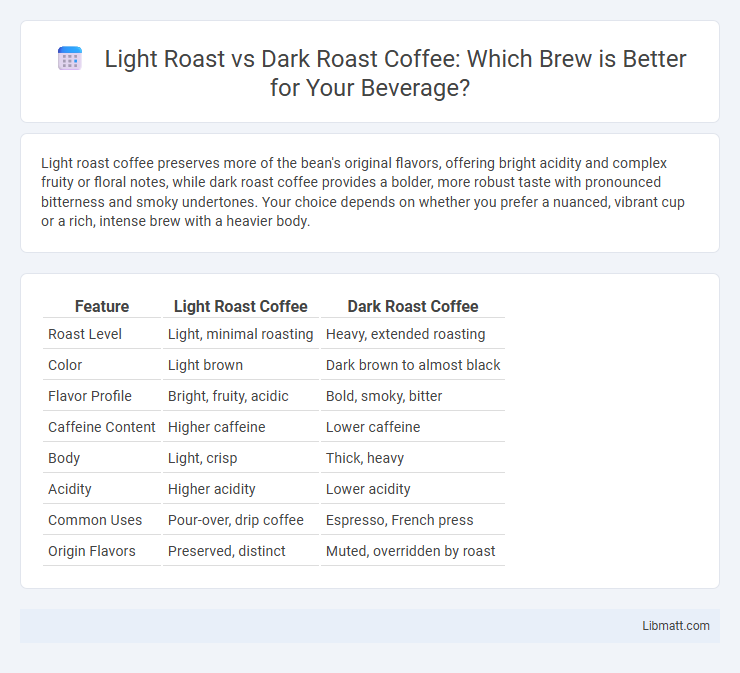Light roast coffee preserves more of the bean's original flavors, offering bright acidity and complex fruity or floral notes, while dark roast coffee provides a bolder, more robust taste with pronounced bitterness and smoky undertones. Your choice depends on whether you prefer a nuanced, vibrant cup or a rich, intense brew with a heavier body.
Table of Comparison
| Feature | Light Roast Coffee | Dark Roast Coffee |
|---|---|---|
| Roast Level | Light, minimal roasting | Heavy, extended roasting |
| Color | Light brown | Dark brown to almost black |
| Flavor Profile | Bright, fruity, acidic | Bold, smoky, bitter |
| Caffeine Content | Higher caffeine | Lower caffeine |
| Body | Light, crisp | Thick, heavy |
| Acidity | Higher acidity | Lower acidity |
| Common Uses | Pour-over, drip coffee | Espresso, French press |
| Origin Flavors | Preserved, distinct | Muted, overridden by roast |
Understanding Light Roast and Dark Roast Coffee
Light roast coffee retains more of the original bean's natural flavors and higher acidity, highlighting fruity and floral notes with a lighter body. Dark roast coffee undergoes longer roasting, resulting in a bolder, more robust flavor with smoky, chocolatey, or caramelized undertones and reduced acidity. The roasting process directly influences caffeine content, with light roasts generally containing slightly more caffeine than dark roasts due to less roasting time.
Key Differences in Flavor Profiles
Light roast coffee features bright, acidic notes with fruity and floral undertones, preserving the bean's original flavors. Dark roast coffee exhibits bold, smoky, and bittersweet flavors due to the longer roasting process, which reduces acidity and enhances caramelization. Understanding these key differences helps you select the coffee that best suits your taste preferences and brewing method.
Caffeine Content: Myths and Facts
Light roast coffee often contains slightly more caffeine by volume than dark roast due to denser bean composition, though the difference is minimal when measured by weight. The roasting process reduces bean mass but not caffeine content, debunking the myth that dark roast coffee has significantly less caffeine. Ultimately, caffeine levels vary more by brewing method and coffee-to-water ratio than by roast type.
The Roasting Process Explained
Light roast coffee beans retain more of their original flavors due to a shorter roasting time, typically heated to 356-401degF (180-205degC), preserving their higher acidity and complex aromas. Dark roast coffee undergoes a longer roasting process at temperatures of 464-482degF (240-250degC), resulting in a bolder, more robust flavor with reduced acidity and oils brought to the surface. The roasting duration and temperature significantly impact the chemical composition, with light roasts emphasizing origin characteristics and dark roasts developing deeper caramelization and smoky notes.
Bean Origins and Roast Preferences
Light roast coffee preserves the unique characteristics of bean origins, highlighting floral and fruity notes from regions such as Ethiopia and Kenya. Dark roast coffee tends to mask these origin-specific flavors with bold, smoky, and caramelized profiles favored in beans from Latin America like Brazil and Colombia. Consumer roast preferences often align with desired flavor intensity and acidity, where light roasts appeal to those seeking nuanced, bright flavors, while dark roasts attract fans of robust, bitter, and fuller-bodied coffee.
Health Benefits of Light vs. Dark Roast
Light roast coffee contains higher levels of chlorogenic acids, which act as antioxidants supporting cardiovascular health and reducing inflammation. Dark roast coffee, while lower in these antioxidants, offers increased levels of compounds like melanoidins that may improve gut health and reduce acid reflux. Both roasts provide caffeine and essential nutrients, but light roast tends to have a more pronounced effect on antioxidant intake, whereas dark roast supports digestive wellness.
Brewing Methods for Each Roast Type
Light roast coffee is best brewed using methods like pour-over, Aeropress, or drip coffee makers, which highlight its bright, acidic notes and delicate flavors by extracting subtle complexities. Dark roast coffee suits brewing methods such as French press or espresso, where the full-bodied, bold, and smoky characteristics are intensified through longer steeping or high-pressure extraction. Adjusting grind size and brewing time accordingly optimizes flavor profiles specific to the roast type, enhancing the overall coffee experience.
How to Choose the Right Roast for You
Choosing the right roast depends on your taste preferences and caffeine needs, as light roast coffee offers a brighter, more acidic flavor with higher caffeine content, while dark roast features a bolder, smokier taste with slightly less caffeine. Consider how you enjoy your coffee: if you prefer fruity, complex aromas, a light roast may suit you best; if you favor a rich, robust, and bitter profile, opt for dark roast. Your brewing method can also influence the choice, with light roasts performing well in pour-over or drip coffee makers, and dark roasts excelling in espresso machines or French presses.
Popular Light and Dark Roast Coffee Brands
Popular light roast coffee brands include Stumptown Coffee Roasters, known for their bright and fruity flavors, and Verve Coffee Roasters, which offers a clean and vibrant cup. For dark roast enthusiasts, brands like Peet's Coffee and Starbucks provide rich, bold profiles with deep caramel and chocolate notes that cater to your preference for a robust brew. Choosing between these brands depends on whether you favor the nuanced acidity of light roasts or the intense, smoky qualities of dark roasts.
Final Thoughts: Which Roast Reigns Supreme?
Light roast coffee preserves more of the bean's original flavors and higher acidity, making it ideal for those who appreciate complex and fruity notes. Dark roast coffee offers a bold, rich, and smoky profile with lower acidity, preferred by fans of intense, robust flavors. Choosing between light and dark roast ultimately depends on individual taste preferences and desired caffeine strength, with light roasts generally containing slightly more caffeine by volume.
Light roast vs dark roast coffee Infographic

 libmatt.com
libmatt.com